Editor's note: Chris Impey is a distinguished professor of astronomy at the University of Arizona. He is the author of several popular science books, including the recent "Dreams of Other Worlds," about 11 iconic NASA astronomy and planetary science missions, co-written with Holly Henry and published by Princeton University Press.
(CNN) -- Lady Gaga announced that she's going to sing in space. Everyone is raving about "Gravity," the new movie starring Sandra Bullock and George Clooney as astronauts in orbit. And India just launched its first Mars mission on Thursday.
Clearly, we Earthlings are still madly in love with space. But what about the moon?
It's sad how far America has fallen in our space aspirations. So far that we can't even get into Earth orbit without help from the Russians, let alone get back to the moon.
 Chris Impey
Chris Impey But NASA is trying to get back in the game. Two months after launch, its Lunar Atmosphere and Dust Environment Explorer -- LADEE, pronounced "laddie" -- has finished its looping journey and it is gathering important information about the moon's dust and thin atmosphere.
Already, this modular spacecraft has tested a new system for interplanetary communication using pulsed lasers, delivering a blistering 622 megabits per second. Try getting that from your Internet service provider.
.cnnArticleGalleryNav{border:1px solid #000;cursor:pointer;float:left;height:25px;text-align:center;width:25px} .cnnArticleGalleryNavOn{background-color:#C03;border:1px solid #000;float:left;height:25px;text-align:center;width:20px} .cnnArticleGalleryNavDisabled{background-color:#222;border:1px solid #000;color:#666;float:left;height:25px;text-align:center;width:25px} .cnnArticleExpandableTarget{background-color:#000;display:none;position:absolute} .cnnArticlePhotoContainer{height:122px;width:214px} .cnnArticleBoxImage{cursor:pointer;height:122px;padding-top:0;width:214px} .cnnArticleGalleryCaptionControl{background-color:#000;color:#FFF} .cnnArticleGalleryCaptionControlText{cursor:pointer;float:right;font-size:10px;padding:3px 10px 3px 3px} .cnnArticleGalleryPhotoContainer cite{background:none repeat scroll 0 0 #000;bottom:48px;color:#FFF;height:auto;left:420px;opacity:.7;position:absolute;width:200px;padding:10px} .cnnArticleGalleryClose{background-color:#fff;display:block;text-align:right} .cnnArticleGalleryCloseButton{cursor:pointer} .cnnArticleGalleryNavPrevNext span{background-color:#444;color:#CCC;cursor:pointer;float:left;height:23px;text-align:center;width:26px;padding:4px 0 0} .cnnArticleGalleryNavPrevNextDisabled span{background-color:#444;color:#666;float:left;height:23px;text-align:center;width:25px;padding:4px 0 0} .cnnVerticalGalleryPhoto{padding-right:68px;width:270px;margin:0 auto} .cnnGalleryContainer{float:left;clear:left;margin:0 0 20px;padding:0 0 0 10px} NASA's Lunar Atmosphere and Dust Environment Explorer (LADEE) observatory launches aboard the Minotaur V rocket from the Mid-Atlantic Regional Spaceport at NASA's Wallops Flight Facility on Friday, September 6, in Virginia. LADEE is a robotic mission that will orbit the moon, where it will provide unprecedented information about the environment around the moon and give scientists a better understanding of other planetary bodies in our solar system and beyond. David W. Thompson, chairman and CEO of Orbital Sciences, left, NASA Administrator Charles Bolden and Mrs. Jaqueline Bolden watch the launch on September 6. A rocket carrying a NASA moon orbiter sits on the launch pad in Wallops Island, Virginia, on September 6. The Lunar Atmosphere and Dust Environment Explorer (LADEE) is designed to "orbit the moon to gather detailed information about the lunar atmosphere, conditions near the surface and environmental influences on lunar dust," NASA said. During final preparations for launch, engineers mount the spacecraft onto a spin table and rotate it at high speeds to make sure it's perfectly balanced for flight. The moon orbiter sits in the nose-cone at the top of the Minotaur V rocket, a ballistic missile converted into a space launch vehicle. NASA engineers at the Wallops Flight Facility in Virginia load the spacecraft into the rocket's nose-cone. LADEE is the first spacecraft designed, developed, built and tested at NASA's Ames Research Center in Moffett Field, California. Engineers prepare to put the rocket into place. Photos: NASA launches moon orbiter Photos: NASA launches moon orbiter Photos: NASA launches moon orbiter NASA launches moon orbiter NASA launches moon orbiter NASA launches moon orbiter NASA launches moon orbiter NASA launches moon orbiter HIDE CAPTION << <
NASA's Lunar Atmosphere and Dust Environment Explorer (LADEE) observatory launches aboard the Minotaur V rocket from the Mid-Atlantic Regional Spaceport at NASA's Wallops Flight Facility on Friday, September 6, in Virginia. LADEE is a robotic mission that will orbit the moon, where it will provide unprecedented information about the environment around the moon and give scientists a better understanding of other planetary bodies in our solar system and beyond. David W. Thompson, chairman and CEO of Orbital Sciences, left, NASA Administrator Charles Bolden and Mrs. Jaqueline Bolden watch the launch on September 6. A rocket carrying a NASA moon orbiter sits on the launch pad in Wallops Island, Virginia, on September 6. The Lunar Atmosphere and Dust Environment Explorer (LADEE) is designed to "orbit the moon to gather detailed information about the lunar atmosphere, conditions near the surface and environmental influences on lunar dust," NASA said. During final preparations for launch, engineers mount the spacecraft onto a spin table and rotate it at high speeds to make sure it's perfectly balanced for flight. The moon orbiter sits in the nose-cone at the top of the Minotaur V rocket, a ballistic missile converted into a space launch vehicle. NASA engineers at the Wallops Flight Facility in Virginia load the spacecraft into the rocket's nose-cone. LADEE is the first spacecraft designed, developed, built and tested at NASA's Ames Research Center in Moffett Field, California. Engineers prepare to put the rocket into place. Photos: NASA launches moon orbiter Photos: NASA launches moon orbiter Photos: NASA launches moon orbiter NASA launches moon orbiter NASA launches moon orbiter NASA launches moon orbiter NASA launches moon orbiter NASA launches moon orbiter HIDE CAPTION << <  1
1  2
2  3
3  4
4  5
5  6
6  7
7  8 > >>
8 > >>  Photos: NASA launches moon orbiter
Photos: NASA launches moon orbiter LADEE is a worthy mission, but it's a far cry from the romance and ambition of space exploration 50 years ago. When Frank Sinatra released a swing version of "Fly Me to the Moon" in 1964, the song captured the optimism of the U.S. space program. President John Kennedy had challenged the country to a manned moon landing three years earlier and NASA's budget rose by a factor of five to accomplish the goal.
.cnnArticleGalleryNav{border:1px solid #000;cursor:pointer;float:left;height:25px;text-align:center;width:25px} .cnnArticleGalleryNavOn{background-color:#C03;border:1px solid #000;float:left;height:25px;text-align:center;width:20px} .cnnArticleGalleryNavDisabled{background-color:#222;border:1px solid #000;color:#666;float:left;height:25px;text-align:center;width:25px} .cnnArticleExpandableTarget{background-color:#000;display:none;position:absolute} .cnnArticlePhotoContainer{height:122px;width:214px} .cnnArticleBoxImage{cursor:pointer;height:122px;padding-top:0;width:214px} .cnnArticleGalleryCaptionControl{background-color:#000;color:#FFF} .cnnArticleGalleryCaptionControlText{cursor:pointer;float:right;font-size:10px;padding:3px 10px 3px 3px} .cnnArticleGalleryPhotoContainer cite{background:none repeat scroll 0 0 #000;bottom:48px;color:#FFF;height:auto;left:420px;opacity:.7;position:absolute;width:200px;padding:10px} .cnnArticleGalleryClose{background-color:#fff;display:block;text-align:right} .cnnArticleGalleryCloseButton{cursor:pointer} .cnnArticleGalleryNavPrevNext span{background-color:#444;color:#CCC;cursor:pointer;float:left;height:23px;text-align:center;width:26px;padding:4px 0 0} .cnnArticleGalleryNavPrevNextDisabled span{background-color:#444;color:#666;float:left;height:23px;text-align:center;width:25px;padding:4px 0 0} .cnnVerticalGalleryPhoto{padding-right:68px;width:270px;margin:0 auto} .cnnGalleryContainer{float:left;clear:left;margin:0 0 20px;padding:0 0 0 10px}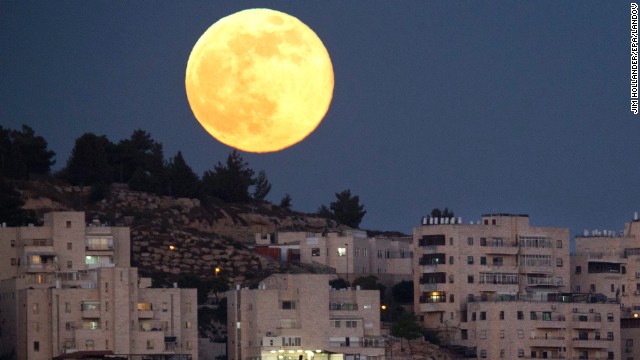 The biggest and brightest moon of the year rises over a Jerusalem neighborhood on Sunday, June 23. The magic moment happened early June 23 when the moon was at the closest point to Earth in its orbit. A supermoon, which occurs once a year, is 14% larger and 30% brighter than most full moons, according to NASA. The supermoon rises over Rome on June 23. The moon hangs over the Manhattan skyline on June 23. The moon rises behind the Washington Monument on June 23. Camels wander under the moon as it rises over the Judean Desert in the West Bank on June 23. Onlookers view the full moon over the city of Rome on June 23. The full moon rises over Lisbon, Portugal, on June 23. The supermoon is seen behind the Marina district towers in Dubai, United Arab Emirates, on June 23. The Supermoon is seen over the Statue of Liberty on June 23 in New York. This view is behind a building of the Forbidden City in Beijing on June 23. The moon lights the sky over San Salvador, the capital of El Salvador, on June 23. A cotton candy vendor weaves through the crowd during the Los Angeles Angels' baseball game against the Pittsburgh Pirates on Saturday, June 22. A full moon rises behind the Jefferson Memorial in Washington on June 22. The Supermoon rises over the temple of Poseidon, the ancient Greek god of the seas, as the sun sets on Cape Sounion outside Athens, Greece, on June 22. The moon rises behind the Peter and Paul Fortress in St. Petersburg, Russia, on June 22. The moon hangs in the sky over Rotterdam, the Netherlands, on June 22. Share your Supermoon stories. Supermoon circles the globe Supermoon circles the globe Supermoon circles the globe Supermoon circles the globe Supermoon circles the globe Supermoon circles the globe Photos: Supermoon circles the globe Supermoon circles the globe Supermoon circles the globe Supermoon circles the globe Supermoon circles the globe Supermoon circles the globe Supermoon circles the globe Supermoon circles the globe Supermoon circles the globe Supermoon circles the globe HIDE CAPTION << <
The biggest and brightest moon of the year rises over a Jerusalem neighborhood on Sunday, June 23. The magic moment happened early June 23 when the moon was at the closest point to Earth in its orbit. A supermoon, which occurs once a year, is 14% larger and 30% brighter than most full moons, according to NASA. The supermoon rises over Rome on June 23. The moon hangs over the Manhattan skyline on June 23. The moon rises behind the Washington Monument on June 23. Camels wander under the moon as it rises over the Judean Desert in the West Bank on June 23. Onlookers view the full moon over the city of Rome on June 23. The full moon rises over Lisbon, Portugal, on June 23. The supermoon is seen behind the Marina district towers in Dubai, United Arab Emirates, on June 23. The Supermoon is seen over the Statue of Liberty on June 23 in New York. This view is behind a building of the Forbidden City in Beijing on June 23. The moon lights the sky over San Salvador, the capital of El Salvador, on June 23. A cotton candy vendor weaves through the crowd during the Los Angeles Angels' baseball game against the Pittsburgh Pirates on Saturday, June 22. A full moon rises behind the Jefferson Memorial in Washington on June 22. The Supermoon rises over the temple of Poseidon, the ancient Greek god of the seas, as the sun sets on Cape Sounion outside Athens, Greece, on June 22. The moon rises behind the Peter and Paul Fortress in St. Petersburg, Russia, on June 22. The moon hangs in the sky over Rotterdam, the Netherlands, on June 22. Share your Supermoon stories. Supermoon circles the globe Supermoon circles the globe Supermoon circles the globe Supermoon circles the globe Supermoon circles the globe Supermoon circles the globe Photos: Supermoon circles the globe Supermoon circles the globe Supermoon circles the globe Supermoon circles the globe Supermoon circles the globe Supermoon circles the globe Supermoon circles the globe Supermoon circles the globe Supermoon circles the globe Supermoon circles the globe HIDE CAPTION << <  1
1  2
2  3
3  4
4  5
5  6
6  7
7  8
8  9
9  10
10  11
11  12
12  13
13  14
14  15
15  16 > >>
16 > >>  Photos: Supermoon circles the globe
Photos: Supermoon circles the globe The moon landings were a phenomenal achievement. Even knowing that they were motivated by a rivalry with the Soviets and fueled by an unsustainable budget didn't tarnish their luster. The Saturn V was the largest and most powerful rocket ever built, and the Apollo program was the most technically complex human undertaking in history. Two dozen brave and daring astronauts reached their target with computer processors less powerful than those inside our modern-day smartphones. The 12 who loped across the lunar soil are the only people to set foot on another world.
Today, the Apollo moon shots fade and flicker in the public consciousness, like the grainy black-and-white TV images that many of us recall from just over 44 years ago. About 6% of the American public thought the moon landings were a hoax, despite high resolution images that show the landers and tracks left by the rovers, and ongoing scientific experiments using the hardware we left behind.
I used to get annoyed at the Apollo deniers. (Buzz Aldrin at least managed to get even; YouTube videos where he decks conspiracy theorist and filmmaker Bart Sibrel have been watched more than half a million times). Then I realized that a list of things that one in 10 Americans believes would include some pretty outrageous things. But willful cultural ignorance is sad.
New players are stepping into the vacuum. Google announced the Lunar X Prize in 2007, riffing off the successful Ansari XPRIZE, where private teams were challenged to build a reusable spacecraft to reach the boundary of outer space. A $20 million prize will go to the first team to land a robot on the moon that can travel 500 meters and transmit images and video. Twenty teams are still in the running. The competition expires when all the prizes have been claimed or at the end of 2015, whichever comes first.
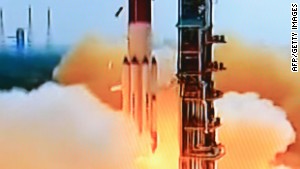 India launches mission to Mars
India launches mission to Mars China is likely to beat all these teams to the punch. A few weeks ago the Chinese announced that the Chang'e 3 lunar rover will be launched by the end of the year. If successful, it would be the first soft landing on the moon since the Russian Luna 24 in 1976. Less than a decade old, China's space program is well-funded and aggressive. China has put 15 astronauts in orbit and plans to complete a 60-ton space station by 2020. Following Chang'e 3, they plan sample return by 2020 and a manned landing by 2025. So, more than half a century after Eugene Cernan left the last human footprint on the moon, the next may be made by someone who speaks Mandarin.
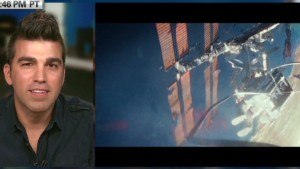 Rocket scientist weighs in on 'Gravity'
Rocket scientist weighs in on 'Gravity' Meanwhile, other countries are getting into the act. The European Space Agency has long-term plans to send robots and astronauts to the moon. Japan and India also have advanced plans for lunar rovers. The United States led the world in space but NASA is cooling its heels, with a vision that has shrunk along with its budget.
America's space program would be best served by continuing the mission started 50 years ago. The moon still has much to teach us about how the solar system and the Earth formed. It's not the sterile place we once thought; there's enough water and oxygen in the soil to easily sustain a base. It's the perfect place for learning how to live and work beyond the Earth.
When Sinatra performed "Fly Me to the Moon" on his TV show in 1969 he dedicated it to the Apollo astronauts "who made the impossible possible."
LADEE was designed to characterize the lunar environment in preparation for future human missions. But the Constellation Program that would have gotten us back to the Moon was canceled in 2010. LADEE will set the table but no one's coming to dinner.
By partnering with other countries or private sector companies, NASA can rekindle the dream and fulfill our destiny to explore beyond our planet.
Follow us on Twitter @CNNOpinion.
Join us on Facebook/CNNOpinion.
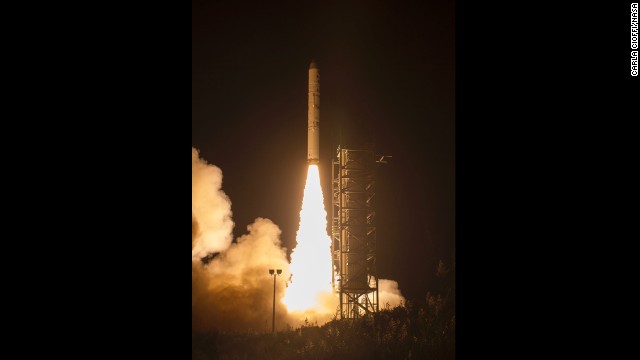 LADEE is a robotic mission that will orbit the moon, where it will provide unprecedented information about the environment around the moon and give scientists a better understanding of other planetary bodies in our solar system and beyond.
LADEE is a robotic mission that will orbit the moon, where it will provide unprecedented information about the environment around the moon and give scientists a better understanding of other planetary bodies in our solar system and beyond. 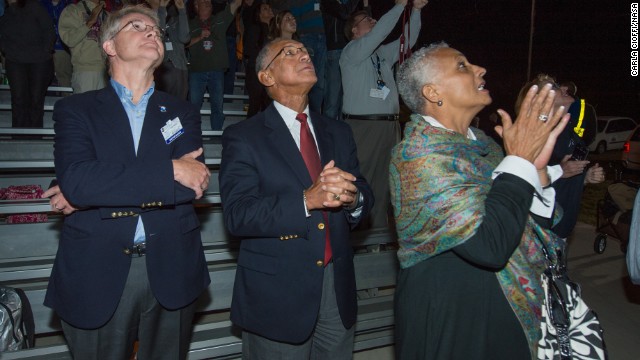 David W. Thompson, chairman and CEO of Orbital Sciences, left, NASA Administrator Charles Bolden and Mrs. Jaqueline Bolden watch the launch on September 6.
David W. Thompson, chairman and CEO of Orbital Sciences, left, NASA Administrator Charles Bolden and Mrs. Jaqueline Bolden watch the launch on September 6. 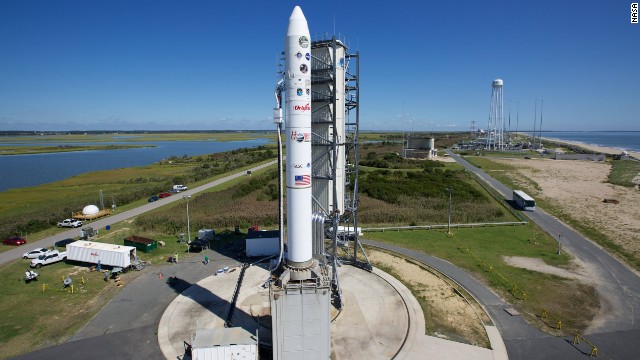 A rocket carrying a NASA moon orbiter sits on the launch pad in Wallops Island, Virginia, on September 6. The Lunar Atmosphere and Dust Environment Explorer (LADEE) is designed to "orbit the moon to gather detailed information about the lunar atmosphere, conditions near the surface and environmental influences on lunar dust," NASA said.
A rocket carrying a NASA moon orbiter sits on the launch pad in Wallops Island, Virginia, on September 6. The Lunar Atmosphere and Dust Environment Explorer (LADEE) is designed to "orbit the moon to gather detailed information about the lunar atmosphere, conditions near the surface and environmental influences on lunar dust," NASA said. 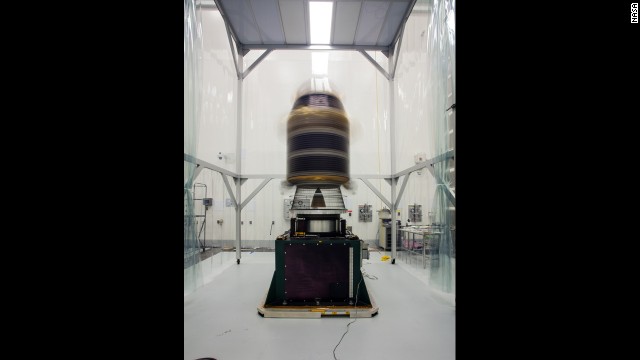 During final preparations for launch, engineers mount the spacecraft onto a spin table and rotate it at high speeds to make sure it's perfectly balanced for flight.
During final preparations for launch, engineers mount the spacecraft onto a spin table and rotate it at high speeds to make sure it's perfectly balanced for flight. 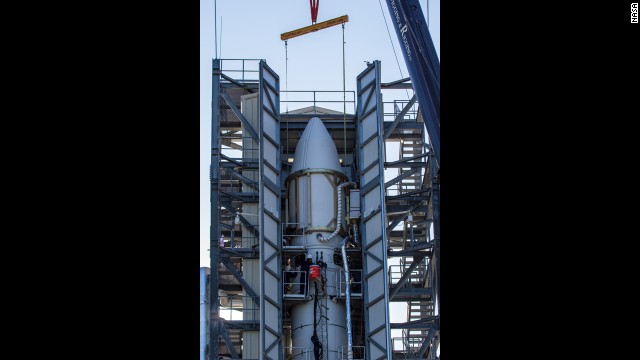 The moon orbiter sits in the nose-cone at the top of the Minotaur V rocket, a ballistic missile converted into a space launch vehicle.
The moon orbiter sits in the nose-cone at the top of the Minotaur V rocket, a ballistic missile converted into a space launch vehicle. 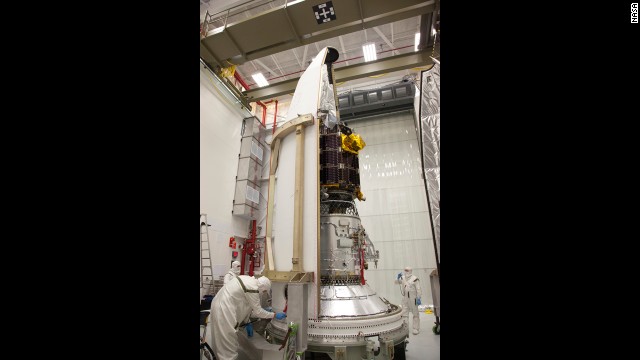 NASA engineers at the Wallops Flight Facility in Virginia load the spacecraft into the rocket's nose-cone. LADEE is the first spacecraft designed, developed, built and tested at NASA's Ames Research Center in Moffett Field, California.
NASA engineers at the Wallops Flight Facility in Virginia load the spacecraft into the rocket's nose-cone. LADEE is the first spacecraft designed, developed, built and tested at NASA's Ames Research Center in Moffett Field, California. 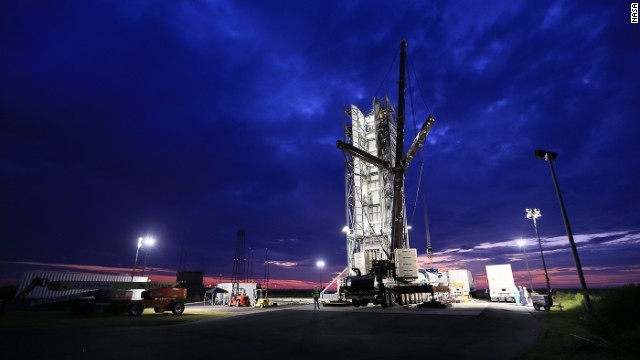 Engineers prepare to put the rocket into place. Photos: NASA launches moon orbiter Photos: NASA launches moon orbiter Photos: NASA launches moon orbiter NASA launches moon orbiter NASA launches moon orbiter NASA launches moon orbiter NASA launches moon orbiter NASA launches moon orbiter HIDE CAPTION << <
Engineers prepare to put the rocket into place. Photos: NASA launches moon orbiter Photos: NASA launches moon orbiter Photos: NASA launches moon orbiter NASA launches moon orbiter NASA launches moon orbiter NASA launches moon orbiter NASA launches moon orbiter NASA launches moon orbiter HIDE CAPTION << < 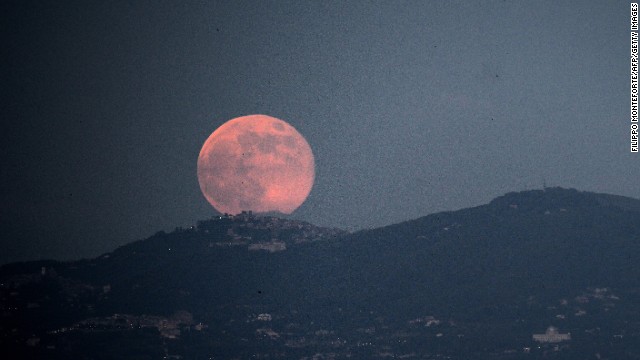 The supermoon rises over Rome on June 23.
The supermoon rises over Rome on June 23. 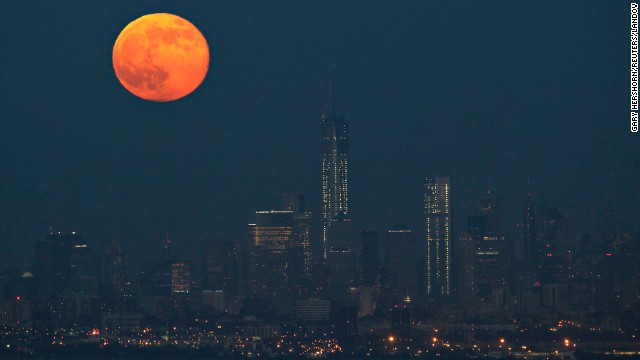 The moon hangs over the Manhattan skyline on June 23.
The moon hangs over the Manhattan skyline on June 23. 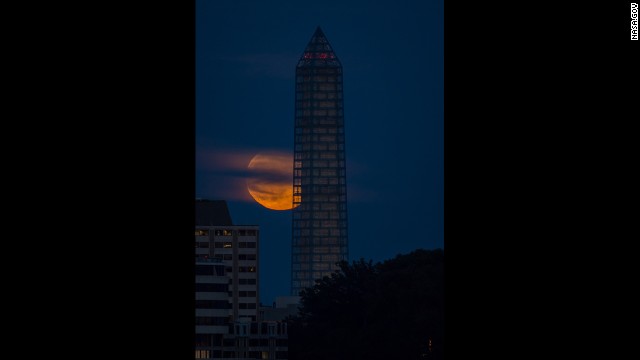 The moon rises behind the Washington Monument on June 23.
The moon rises behind the Washington Monument on June 23. 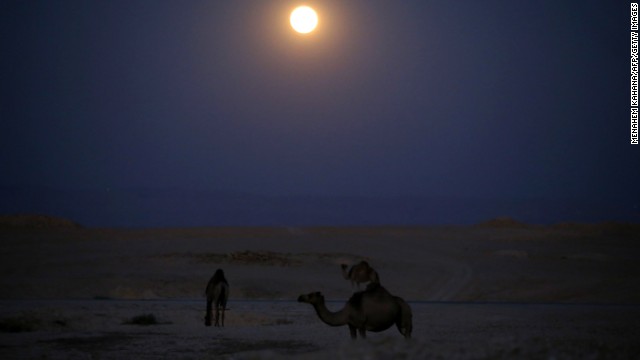 Camels wander under the moon as it rises over the Judean Desert in the West Bank on June 23.
Camels wander under the moon as it rises over the Judean Desert in the West Bank on June 23.  Onlookers view the full moon over the city of Rome on June 23.
Onlookers view the full moon over the city of Rome on June 23. 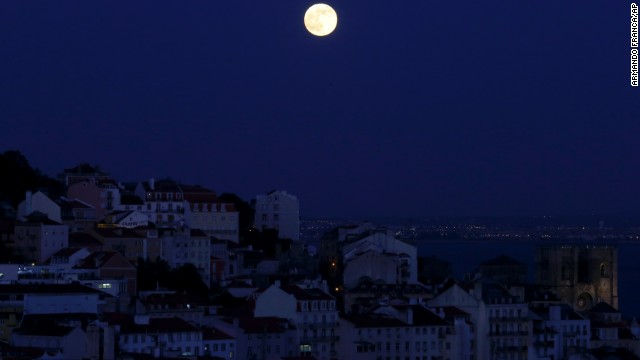 The full moon rises over Lisbon, Portugal, on June 23.
The full moon rises over Lisbon, Portugal, on June 23.  The supermoon is seen behind the Marina district towers in Dubai, United Arab Emirates, on June 23.
The supermoon is seen behind the Marina district towers in Dubai, United Arab Emirates, on June 23. 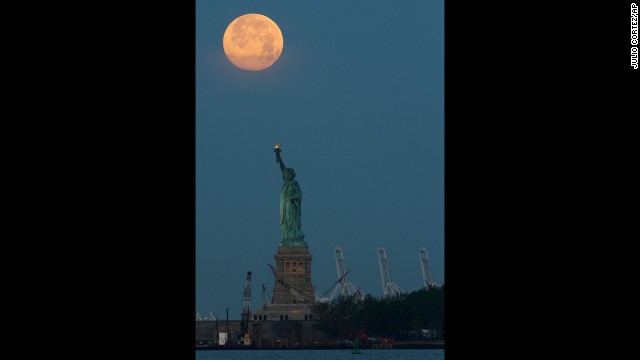 The Supermoon is seen over the Statue of Liberty on June 23 in New York.
The Supermoon is seen over the Statue of Liberty on June 23 in New York. 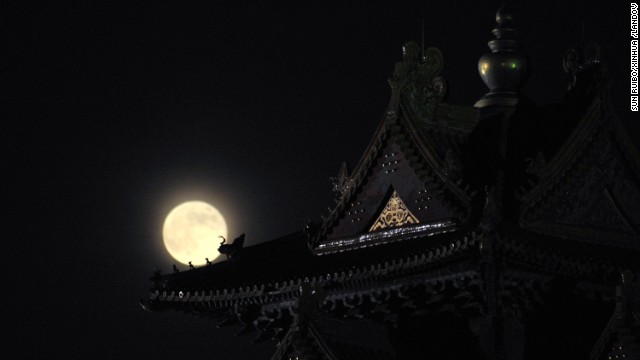 This view is behind a building of the Forbidden City in Beijing on June 23.
This view is behind a building of the Forbidden City in Beijing on June 23. 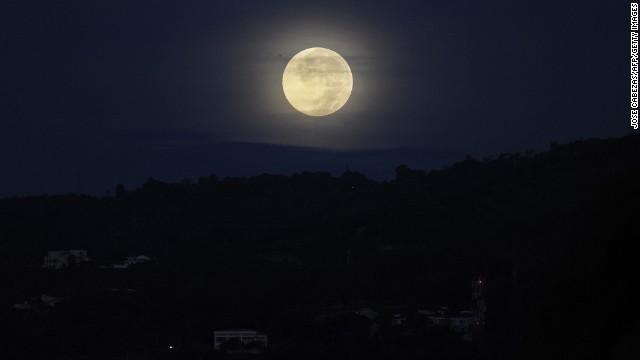 The moon lights the sky over San Salvador, the capital of El Salvador, on June 23.
The moon lights the sky over San Salvador, the capital of El Salvador, on June 23.  A cotton candy vendor weaves through the crowd during the Los Angeles Angels' baseball game against the Pittsburgh Pirates on Saturday, June 22.
A cotton candy vendor weaves through the crowd during the Los Angeles Angels' baseball game against the Pittsburgh Pirates on Saturday, June 22. 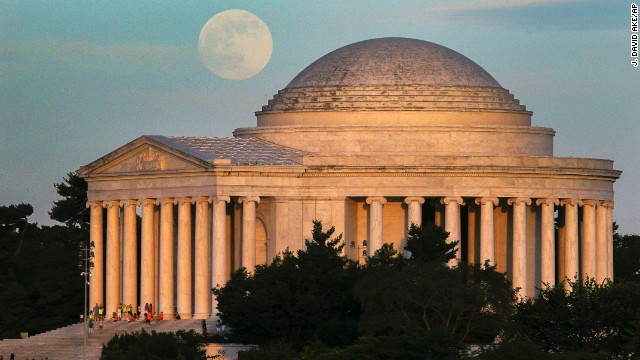 A full moon rises behind the Jefferson Memorial in Washington on June 22.
A full moon rises behind the Jefferson Memorial in Washington on June 22. 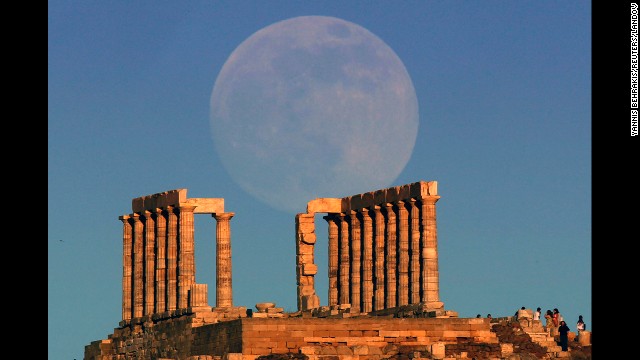 The Supermoon rises over the temple of Poseidon, the ancient Greek god of the seas, as the sun sets on Cape Sounion outside Athens, Greece, on June 22.
The Supermoon rises over the temple of Poseidon, the ancient Greek god of the seas, as the sun sets on Cape Sounion outside Athens, Greece, on June 22.  The moon rises behind the Peter and Paul Fortress in St. Petersburg, Russia, on June 22.
The moon rises behind the Peter and Paul Fortress in St. Petersburg, Russia, on June 22. 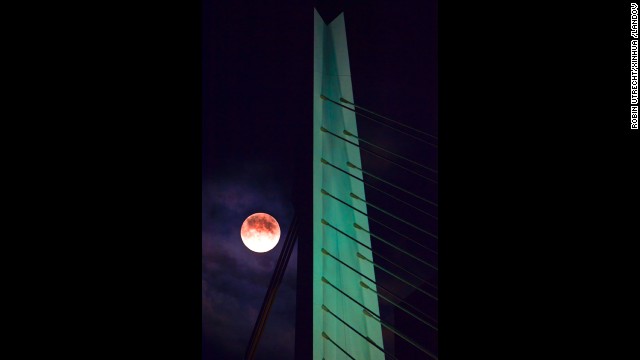 The moon hangs in the sky over Rotterdam, the Netherlands, on June 22. Share your Supermoon stories. Supermoon circles the globe Supermoon circles the globe Supermoon circles the globe Supermoon circles the globe Supermoon circles the globe Supermoon circles the globe Photos: Supermoon circles the globe Supermoon circles the globe Supermoon circles the globe Supermoon circles the globe Supermoon circles the globe Supermoon circles the globe Supermoon circles the globe Supermoon circles the globe Supermoon circles the globe Supermoon circles the globe HIDE CAPTION << <
The moon hangs in the sky over Rotterdam, the Netherlands, on June 22. Share your Supermoon stories. Supermoon circles the globe Supermoon circles the globe Supermoon circles the globe Supermoon circles the globe Supermoon circles the globe Supermoon circles the globe Photos: Supermoon circles the globe Supermoon circles the globe Supermoon circles the globe Supermoon circles the globe Supermoon circles the globe Supermoon circles the globe Supermoon circles the globe Supermoon circles the globe Supermoon circles the globe Supermoon circles the globe HIDE CAPTION << <
{ 0 comments... read them below or add one }
Post a Comment